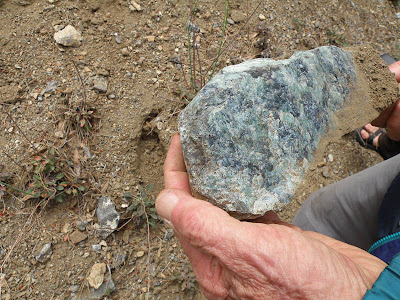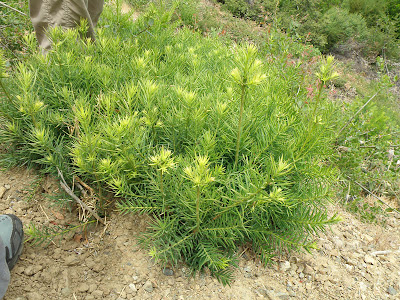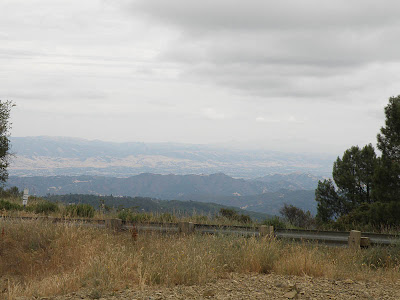As we walked an experienced young tracker was paying less attention to the plants than to footprints and scat at the trailside. Not so pretty as a flower but fascinating to help build up a picture of life in the wild.
![]() |
| Maybe I should have opened with a prettier picture.... But this was as interesting as any flower. Fox maybe? There were fox-like prints nearby, according to the tracker on the hike. |
![]() |
| Squint to see the spotted skunk foot print, two small round pads behind and five toes with claw mark in front of each. |
She recommended a book...
Mammal Tracks and Sign, by Mark Elbroch. Oh my - so much to learn!
Later that day I had my own experience of "tracking" -- it helped me figure out that a raccoon had been in the cottage! Not only did he (or she) make a mess of the dog kibble we keep in there, but she (or he) also left a little hand-shaped footprint, just inside the dog door we forgot to close up!
![]() |
| There's a reason they call raccoons bandits - and it isn't just their mask! |
I'm also trying to learn about birds as well as plants, so on the hike, I was trying to stay close to our leader Randy Morgan, to benefit from his observations along the way. Randy is a great birder. I told him about one bird I've been trying to ID:
Me: It is way h,igh in the trees and
Randy: Oh, and it sounds like this -- he whistled the three note song - that's an olive-sided flycatcher.
Me: (mouth agape) Yes! You're right.
He liked my observation that it sounds like a whistled version of a California quail's call (commonly rendered by the word Chicago). I didn't even get to my astute observations that it seemed to have a band of white down the front and a large-ish head. Well here's a photo so you can see the bird itself, from the
All About Birds page:
![]() |
| Olive-sided flycatcher |
We also saw a flash of a blue grey gnatcatcher. Now I don't remember the small voice it had. But fortunately you can get a good look and listen on it's
All About Birds page.
Another very cool non-plant event on the trip was a whiptail lizard crossing the trail. It looked to be at least 12 inches long. Here's a picture from
CaliforniaHerps:
![]() |
| Whiptail lizard (not sure if it's the coastal species or not) |
She stopped for quite a good long time so we could all get a good look. I think they pay them extra for that. I didn't want to risk frightening him off so I didn't raise my camera for a shot. I read the following interesting fact in an article (which may not be there now, but I read it in a
Scientific American article by Katherine Harmon):
Since the 1960s scientists have known that some species of whiptail lizards need a male even less than a fish needs a bicycle. These all-lady lizard species (of the Aspidoscelis genus) from Mexico and the U.S. Southwest manage to produce well-bred offspring without the aid of male fertilization.
Wow!
Here are some other photos from that day...
Oh, I would also like to mention that Dylan Neubauer was along on this trip and helped me with a lot of IDs and also gave me some tips for identifying different local oaks, which I might write about another time. A former student of Randy's, she has risen to prominence in Santa Cruz County as a botanist par excellence, and, with Randy, has been updating the county's checklist,
An Annotated Checklist of the Vascular Plants of Santa Cruz County, California. So locals, don't buy a copy now -- wait for the updated version, out soon!
![]() |
| Wow! Clematis lasiantha, chaparral clematis |
![]() |
| Looking um. west? we saw Mount Umunhum. |
Interestingly, there is a plan to convert the former military installation on top of Mount Umunhum into an open space preserve - and some controversy about whether to keep the cube-shaped radar tower on top (just visible on the flat peak at the right side) or remove it. (See
this page for more.) My initial gut feeling is to keep it as a historical monument. I visited my sister who lived in South San Jose in the late 60s-early 70s. I remember seeing the radar scanner going around on top of this box. I found it terrifying that they were actively "defending" against the Soviet threat. And yet to my bafflement, people in California would ask me if I felt afraid living in the U.K., being so close to Russia and all!
But I probably am swinging towards the other view - remove that temporary abomination on the land and return it to its native state. Sort of native state. There is no "returning" really. The past is a foreign country as 'tis said.
Umunhum is a transliteration of a name that means Hummingbird's resting place in the Ohlone language. Or maybe Amah Mutsun is the more current name for the local native people. Or maybe that's a more specific sub-group within the Ohlone people. I'm still getting all that straight. Back to the flowers...
![]() |
| Collomia grandiflora - same family as Indian paintbrush. Found in most parts of California. |
![]() |
| Hoita strobilina, Loma Prieta hoita - a rare native plant. It has leaves of three, something like poison oak, except the leaves are oval. Pretty lupine-like flower. |
![]() |
| This species, Eriophyllum lanatum or woolly sunflower, has single flowers. It is related to one that I grow from local natives -- Eriophylum confertiflora (common name: golden yarrow though it's not yarrow). The one I grow has multiple flowers on the inflorescence. We also saw some apparently natural hybrids of these two. |
![]() |
| This pretty is squirreltail grass, Elymus elymoides, or possibly Elymus multicetus |
![]() |
| I resisted the urge to collect! Probably seed pods of Fritillaria affinis, checker lily. |
![]() |
| We entered an area of serpentinite, which is our state mineral actually. |
There was a movement a while back to remove serpentinite from its status as our state mineral because it has some sort of asbestos in it -- but it was all a flap with no scientific basis. Yes there is some asbestos component and no you can't inhale it and get cancer from it without really really trying to get that powder out to inhale it for many many years. I think it's the state rock because it's associated with gold deposits - or because at one point they thought they could mine it for asbestos and make money -- but better to think it's because of the unique flora that grows on serpentine. Here's an interesting article about all this. Edgewood park on the Santa Clara Valley side of the mountains from me has interesting serpentine grassland plant communities. Here's a Bay Nature article on that.
Rambling on with the hike, and this post! ... ![]() |
| A view from the trail. Sorry - not sure what exactly we're looking at - just gives you an idea of the chaparral up there. |
![]() |
| Silverpuffs, Uropappus lindleyi, nestling in shrubs. Very shiny pappi. Flower is dandelion-like. |
![]() |
| Nutmeg - Torreyana californica. Some expressed the thought that the trailside whacking was a bit extreme here and mourned what must have been a nice big shrub (or small tree) now stump sprouting here. Lovely foliage. |
![]() |
| Oh I think this was a white version of coyote mint which is normally bluish purplish. |
![]() |
| Venus thistle, Circium occidentale. A pretty raspberry color. Isn't it funny how knowing something is "good" makes it more pretty? I do try always to admire the beauty of weeds such as bull thistle. And then I yank them. |
![]() |
| And this is the fluffy seed head of the venus thistle. Much relished by wildlife. Much like the seedhead of the bull thistle ;-} |
![]() |
| Um... That's the thing with hikes - so many new flowers and things. More Hoita strobilina maybe? Darn! |
![]() |
| Elymus glaucus, blue wild rye, tall and slim grass in the foreground - bit hard to see. |
Nice elegant grass. I thought. Until I looked up its entry on Las Pilitas Nursery website which ends "We grow it primarily for the garden designers that do not read this." I'm idly looking for warm season grasses that might look nice in the garden, and that are locally native. I don't see any around my immediate vicinity though.
![]() |
| The interesting foliage of Indian Warrior, Pedicularis densiflora, a plant that is hemiparasitic on other chaparral plants, and has a lovely raspberry colored flower. Not often successfully grown in a garden. The physical connection is apparently not discoverable (cue the twilight zone music!). |
Indian paintbrush,
Castilleja affinis, is also said to be hemiparasitic though it can also survive on its own. Las Pilitas likes it for a garden plant. I have seeds of Indian paintbrush, gathered locally! I'm looking forward to trying to germinate them soon.
![]() |
| A shot from the roadside, near the end of the hike - looking over to Morgan Hill and, I believe, Henry Coe State Park, where I really really must go sometime, and if I do - I'm sure I'll find lots there to share in another post. |






















